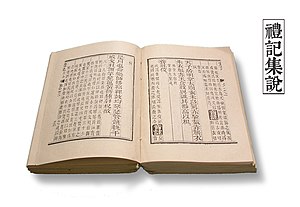Recto and verso


Rectois the "right" or "front" side andversois the "left" or "back" side when text is written or printed on aleaf of paper(folium) in a bound item such as acodex,book,broadsheet,orpamphlet.
Indouble-sided printing,each leaf has twopages– front and back. In modern books, the physicalsheets of paperare stacked and folded in half, producing two leaves and four pages for each sheet. For example, the outer sheet in a 16-page book will have one leaf with pages 1 (recto) and 2 (verso), and another leaf with pages 15 (recto) and 16 (verso). Pages 1 and 16, for example, are printed on the same side of the physical sheet of paper, combining recto and verso sides of different leaves. The number of pages in a book using this binding technique must thus be a multiple of four, and the number of leaves must be a multiple of two, but unused pages are typically left unnumbered and uncounted. A sheet folded in this manner is known as afolio,a word also used for a book or pamphlet made with this technique.
Looseleafpaper consists of unbound leaves. Sometimes single-sided or blank leaves are used for numbering or counting and abbreviated "l." instead of "p." for the number of pages.
Etymology
[edit]The terms are shortened from Latin:rēctō foliōandversō foliō(which translate as "on the right side of the leaf" and "on the back side of the leaf" ). The two oppositepagesthemselves are calledfolium rēctumandfolium versumin Latin,[1]and the ablativerēctō,versōalready imply that the text on the page (and not the physical page itself) are referred to.
Usage
[edit]
Incodicology,each physical sheet (folium,abbreviatedfol.orf.) of amanuscriptis numbered, and the sides are referred to asfolium rēctumandfolium versum,abbreviated asrandvrespectively. Editions of manuscripts will thus mark the position of text in the original manuscript in the formfol. 1r,sometimes with therandvin superscript, as in1r,or with a superscriptoindicating theablativerēctō foliō,versō,as in1ro.[2]This terminology has been standard since the beginnings of modern codicology in the 17th century.
In 2011, Martyn Lyons argued that the termrēctum"right, correct, proper" for the front side of the leaf derives from the use ofpapyrusinlate antiquity,as a different grain ran across each side, and only one side was suitable to be written on, so that usually papyrus would carry writing only on the "correct", smooth side (and just in exceptional cases would there be writing on the reverse side of the leaf).[3]
The terms "recto" and "verso" are also used in the codicology of manuscripts written inright-to-left scripts,likeSyriac,ArabicandHebrew.However, as these scripts are written in the other direction to the scripts witnessed in European codices, the recto page is to the left while the verso is to the right. The reading order of eachfolioremains first verso, then recto, regardless ofwriting direction.
The terms are carried over intoprinting;recto-verso[4]is the norm for printed books but was an important advantage of theprinting pressover the much older Asianwoodblock printingmethod, which printed by rubbing from behind the page being printed, and so could only print on one side of a piece of paper. The distinction between recto and verso can be convenient in theannotationof scholarly books, particularly inbilingual editiontranslations.
The "recto" and "verso" terms can also be employed for the front and back of a one-sheet artwork, particularly indrawing.Arecto-versodrawing is a sheet with drawings on both sides, for example in asketchbook—although usually in these cases there is no obvious primary side. Some works are planned to exploit being on two sides of the same piece of paper, but usually the works are not intended to be considered together. Paper was relatively expensive in the past; good drawing paper still is much more expensive than normal paper.
By book publishing convention, the first page of a book, and sometimes of each section and chapter of a book, is a recto page,[5]and hence all recto pages will have odd numbers and all verso pages will have even numbers.[6][7]
In many early printed books orincunablesand still in some 16th-century books (e.g.João de Barros'sDécadas da Ásia), it is thefolia( "leaves" ) rather than the pages, that are numbered. Thus, eachfoliumcarries a consecutive number on its recto side, while on the verso side there is no number.[8]This was also very common ine.g.internal company reports in the 20th century, before double-sided printers became commonplace in offices.
See also
[edit]References
[edit]- ^ e.g.Quibus carminibus finitur totum primum folium versum (rectum vacat) voluminis"These poems finish the full back page (the front is blank) of the first leaf of the volume" [Giovanni Battista Audiffredi],Catalogus historico-criticus Romanarum editionum saeculi XV(1783),p. 225.
- ^e.g. Roberts,Longinus on the Sublime: The Greek Text Edited After the Paris Manuscript(2011),170;Wijngaards,The Ordained Women Deacons of the Church's First Millennium(2012),232;etc. Tylus,Manuscrits français de la collection berlinoise disponibles à la Bibliothèque Jagellonne de Cracovie (XVIe-XIXe siècles)(2010)[1]
- ^Martyn Lyons (2011).Books: A Living History.Getty Publications. p. 21.ISBN9781606060834.
- ^Recto versois an expression inFrenchthat means "two sides of a sheet or page". InFlandersthe term recto verso is also used to indicate two-sided printing. Duplex printers are referred to as recto verso printers.
- ^Drake, Paul (2007). "The Basic Elements and Order of a Book".You Ought to Write All That Down.Heritage Books. p. 1.ISBN978-0-7884-0989-9.
- ^Gilad, Suzanne (2007).Copyediting & Proofreading For Dummies.For Dummies.p. 209.ISBN9780470121719.
- ^Merriam–Webster, Inc. (1998).Merriam-Webster's Manual for Writers and Editors.Merriam–Webster. pp.337.ISBN9780877796220.
- ^See e.g. a modern reprint of the 3rdDécada(1563):Ásia de João de Barros: Dos feitos que os Portugueses fizeram no descobrimento e conquista dos mares e terras do Oriente. Tercera Década.Imprensa Nacional – Casa da Moeda, 1992.

